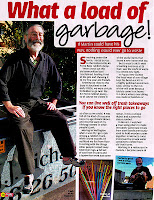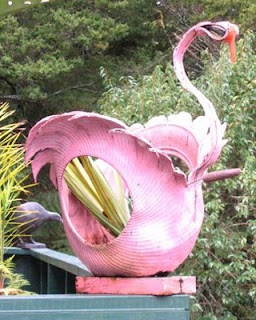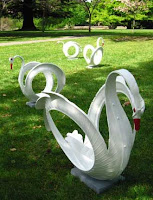lucky break magazine july 2 2012
As told to Paula Trubshaw & photographed by Kristina Rapley - thanks guys for a great job!
The amended text reads:
Sneaking under the cover of the fence, I raced across to the Hobsonville Air force base rubbish dump.
"Wow, check out this old ammunition box!" I exclaimed, hauling it out of the pile and showing it to my five-year old friends.
Growing up close to the base in Auckland in the 1950's we were strictly forbidden to go near the dump - so of course we visited it as often as we could. It was full of the kind of treasures boys of my age dreamed about, and was the start of my lifelong interest in other people's junk.
Moving to Wellington when I was 20, I got a job driving a rubbish truck. Within three months I'd outfitted my flat from floor to ceiling with the things other people tossed away: goat-skin rugs, a full set of cast-iron frying pans, and an old-fashioned typewriter were just some of the useful items that I rescued from the trash.
But it wasn't until I went travelling overseas at 25 that I saw the world of waste in a whole new light.
In Papua New Guinea the headman of a village I stayed in kept his traditional betel-nut kit in a highly polished aluminum tube - a vitamin-C Berocca tube. In a place where everything was made of bamboo or rattan this item was a powerful status-symbol for this chief.
Later, in Mexico, I watched a man on the pavement making trivets from steel bands from packing crates using just a pair of pliers. Miguel told me that he fed his family from the proceeds of his work.
Then in Morocco I watched people making water-carriers from old truck tyres and exquisite jewellery from scrap copper and brass.
While working in a restaurant in Canada, I became of food waste for the first time. As I was about to throw a whole uneaten crab into the waste, I realized that there was nothing wrong with it. The crab was a left-over from a large seafood platter. Diners ate what they could, left the rest - which was dumped. That night I took six uneaten crabs back to my flat - and we dined like kings!
After these experiences I became more and more aware of the politics and economics of waste. Today some 30% of the food produced in New Zealand goes to landfill, producing methane as it rots - this while people in this country go hungry.
As an adbuster and culture-jammer I observe a bombardment of advertising telling us to replace and discard the good we already have. Consumers in first-world countries produce enough waste to feed and support many disadvantaged people the world over.
In an effort to avoid being wasteful consumers themselves, groups of people in the USA initiated "dumpster-diving": instead of buying retail (sooo 20th century!) dumpster-divers rummage through the discards of retailers, residences and offices for useful goods. Other folks, known as "freegans" search through supermarket and restaurant bins for edible food.
On my return to NZ in 2008 I put my observations to good use - my foraging activities led me to the Coromandel where I beachcombed for old jandals, which I cut into fish shapes and sold as wallpieces. Today I also construct interesting clocks from pot lids. colanders, old LPs and flippers.
As I freegan, appalled by the willful waste of food by the multi-nationals and corporates, I rummage in supermarket skips to salvage perfectly edible food - and document my finds on this blog as a kind of public service announcement. I find it disgusting that food is sent to landfill to maximize the profits of the (usually overseas) shareholders while people in the this country are going hungry.
Awake. Arise. Or be forever fallen!.





Comments